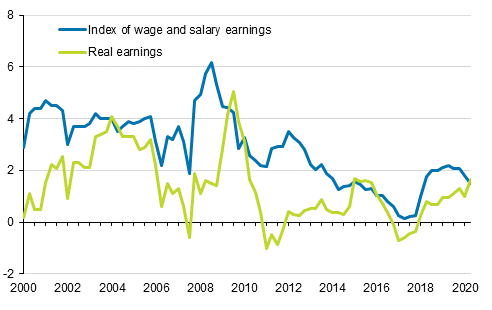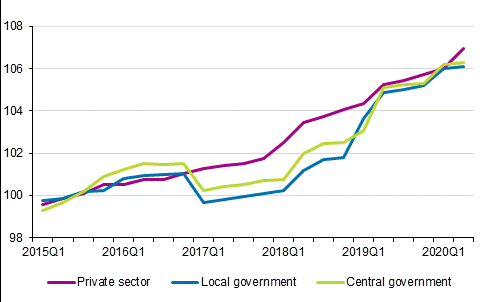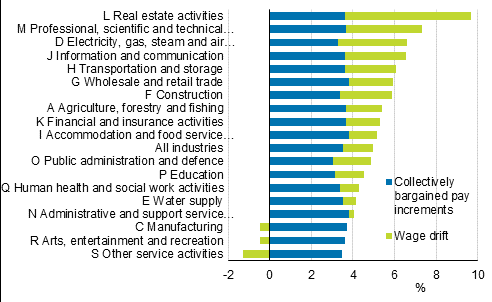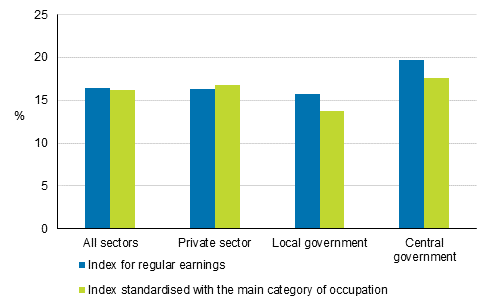Published: 27 August 2020
Wage and salary earners’ earnings for regular working hours rose by 1.5 percent in April-June
According to Statistics Finland’s preliminary data, the index of wage and salary earnings, which measures the rise in the nominal earnings of full-time wage and salary earners, rose by 1.5 per cent in April to June 2020 when compared with the respective period in 2019. Real earnings rose by 1.7 per cent compared to the second quarter of the previous year because of the fall in consumer prices during the second quarter of this year.
Index of wage and salary earnings and real earnings 2000/1 to 2020/2, annual change percentage

According to Statistics Finland’s preliminary data, the nominal earnings of full-time wage and salary earners rose from April to June 2019 to the corresponding period in 2020 by 1.6 per cent in the private sector, by 1.1 per cent in the central government sector and by 1.2 per cent in the local government sector.
The index of regular earnings increased by 1.3 per cent in January to March
The index for regular earnings describes the permanent change in earnings better than the index of wage and salary earnings because it does not take into account performance-based bonuses and non-recurring items included in collective agreements. The index of regular earnings rose by 1.3 per cent in April to June 2020 when compared with the respective period in 2019. The growth amounted to 1.6 per cent in the private sector, to 0.4 per cent in the central government sector, and to 0.4 per cent in the local government sector.
According to preliminary data, earnings of wage and salary earners were 1.8 percent higher in July to September than in the year before
According to Statistics Finland’s preliminary data, nominal earnings of wage and salary earners are 1.8 per cent higher in July to September 2020 than in July to September 2019. According to preliminary data, the index of wage and salary earnings 2015=100 for the third quarter of 2020 is 107.2. Statistics Finland compiles the preliminary third quarter data for the index of wage and salary earnings on the basis of the Employees Pensions Act (2006/395).
The indices for 2020 are based on the effects of agreements and the wage drift
The indices of wage and salary earnings and the indices for regular earnings are final until 2019. They are based on the realised earnings development. The indices for 2020 are preliminary and they are based on estimates of agreement effects and the wage drift. The effects of the exceptional situation caused by the corona virus do not directly influence the index of wage and salary earnings, because the statistics describe development in the average earnings of full-time wage and salary earners for regular working hours. By contrast, if less performance-based bonuses, for example, are paid than before, this is reflected in the development of the index of wage and salary earnings.
Data on the development of earned income in 2020 are available from the national Incomes Register. In the Tieto&trendit blog, Earned income collapsed in the private sector in May 2020 , it is examined how the exceptional situation caused by the corona virus is reflected in the development of earned income (in Finnish only).
The figure below examines the development of the index of wage and salary earnings in 2015 to 2020. The examination ends in the last published quarter, that is, the second quarter of 2020. The cut in public sector holiday bonuses agreed on in the Competitiveness Pact and its ending are visible in the development of the index of wage and salary earnings in the local government and central government sectors in 2017 and 2020. The index of wage and salary earnings fell in the local government sector and in the central government sector in the first quarter of 2017. Correspondingly, the ending of the cuts in holiday bonuses after summer 2019 turned the local and central government sectors’ index of wage and salary earnings upwards at the beginning of 2020.
Development of the index of wage and salary earnings 2015=100 by employer sector in 2015 to 2019

Wage drifts vary more than contractual pay increases in different industries
Earnings development consists of contractual pay increases and wage drift. These together form the earnings development in accordance with the index of wage and salary earnings, and it includes agreement-based non-recurring items and performance-based bonuses. The figure presents the earnings development on the level of main activity categories in the Standard Industrial Classification so that contractual pay increases and wage drift are separated. The examination ends in 2019 because the data are based on realised earnings as far as that year.
Earnings development by industry (TOL2008) in 2015 to 2019

In 2015 to 2019, the earnings development was fastest in real estate activities (9.7 per cent) and in professional, scientific and technical activities (7.3 per cent). In these industries the share of the wage drift in earnings development was also highest. The earnings development was slowest in other service activities (2.2 per cent), arts, entertainment and recreation (3.2 per cent) and manufacturing (3.2 per cent). In these industries, the wage drift was negative in 2015 to 2019. However, the earnings development as a whole was not negative, because apart from wage drifts, the earnings development consists of contractual pay increases.
In 2015 to 2019, the share of contractual pay increases in earnings development was highest in the industries of trade (3.8 per cent), administrative and support service activities (3.8 per cent), and accommodation and food service activities (3.8 per cent). In turn, contractual pay increases were lowest in the industries of public administration and defence (3.1 per cent), education (3.1 per cent), and electricity, gas, steam and air conditioning supply (3.3 per cent).
The earnings development is also affected by the structural change taking place in the industry. The following section examines the effect of changes in the occupational structure on the development of average earnings.
Private sector managers and local government managers were top earners in the 2010s
Starting from 2010, Statistics Finland has calculated an index standardised with the main category of occupation based on the index for regular earnings, in which the earnings development of the main category of occupation in each wage and salary earner group is calculated separately. There are ten of these main categories of occupation, from managers to elementary occupations.
The figure below shows the earnings development standardised with the main category of occupation by employer sector from 2010 to 2019. The main categories of occupation are divided into four categories in the figure so that managers are separately and professionals and technicians and associate professionals are combined into one category. “Clerical support workers” and “service and sales workers” are combined into the category salaried employees and service workers and the worker category is formed by the categories “skilled agricultural, forestry and fishery workers”, “craft and related trades workers”, “plant and machine operators, and assemblers” and “elementary occupations”.
Changes in regular earnings of wage and salary earners from 2010 to 2019 standardised with the main categories of occupation

From 2010 to 2019, the earnings of private sector managers have risen most, by 31 per cent, followed by the earnings of local government managers, by 21 per cent. In these sectors, the rise in the earnings level and the earnings level have had a positive correlation in the past decade. By contrast, the development was opposite in central government. Earnings rose least among managers and most in the occupational groups of salaried employees and workers.
By comparing the index standardised with occupation and the index for regular earnings, we can examine how changes in the occupational structure influence the development of average earnings in different employer sectors, for example. On average, the change in the occupational structure has not much affected the development of the earnings level on the labour market, because from 2010 to 2019, the index standardised with the main category of occupation has risen by only two decimals less than the index for regular earnings without standardisation with occupation.
Change in the index for regular earnings and the index standardised with occupational structure from 2010 to 2019

By contrast, there is a clear difference in development between the private and public sectors. In the private sector, the index standardised with occupational structure has risen in nine years by 0.5 per cent more than the non-standardised index, but in the local government sector, the index standardised with the main category of occupation has risen by two per cent less and in the central government sector by 2.1 per cent less than the non-standardised index.
In the public sector, the occupational structure has thus clearly moved towards better paid occupations, which may partly be due to the outsourcing of organisations' auxiliary activities. There is no clear direction in the private sector, as the effects of structural changes vary in both directions depending on the year.
Source: Index of wage and salary earnings 2020, 2nd quarter. Statistics Finland
Inquiries: Anu Uuttu 029 551 2322, Harri Nummila 029 551 3235, palkat.indeksit@stat.fi
Director in charge: Mari Ylä-Jarkko
Publication in pdf-format (487.8 kB)
- Tables
-
Tables in databases
Pick the data you need into tables, view the data as graphs, or download the data for your use.
Appendix tables
- Appendix table 1. Index of wage and salary earnings 2015=100 by employer sector and base of payment (27.8.2020)
- Appendix table 2. Index of regular earnings 2015=100 by employer sector and base of payment (27.8.2020)
- Appendix table 3. Index of wage and salary earnings 2015=100 by employer sector and gender (27.8.2020)
- Appendix table 4. Index of regular earnings 2015=100 by employer sector and gender (27.8.2020)
- Appendix table 5. Index of wage and salary earnings 2015=100 by industry, (TOL 2008) (27.8.2020)
- Appendix table 6. Index of regular earnings 2015=100 by industry, (TOL 2008) (27.8.2020)
- Appendix table 7. Index of wage and salary earnings 2010=100 by employer sector and gender (27.8.2020)
- Appendix table 8. Index of wage and salary earnings 2010=100 by industry, (TOL 2008) (27.8.2020)
- Appendix table 9. Index of wage and salary earnings 2015=100, percentage changes (27.8.2020)
- Appendix table 10. Index of regular earnings 2015=100, percentage changes (27.8.2020)
- Appendix table 11. Average earnings by employer sector and gender, EUR/month (27.8.2020)
- Revisions in these statistics
-
- Revisions in these statistics (27.8.2020)
Updated 27.8.2020
Official Statistics of Finland (OSF):
Index of wage and salary earnings [e-publication].
ISSN=1798-7814. 2nd quarter 2020. Helsinki: Statistics Finland [referred: 22.12.2025].
Access method: http://stat.fi/til/ati/2020/02/ati_2020_02_2020-08-27_tie_001_en.html

